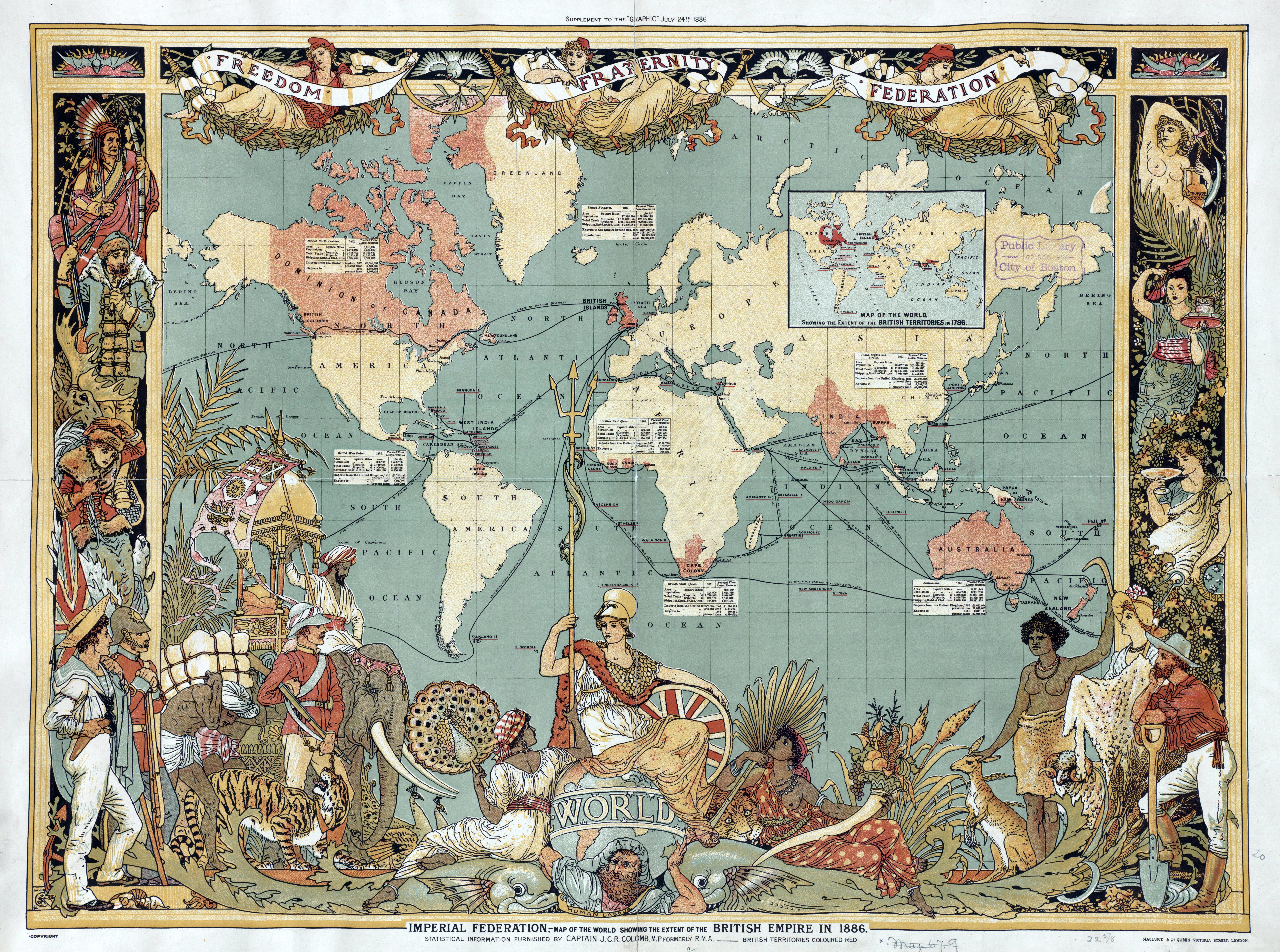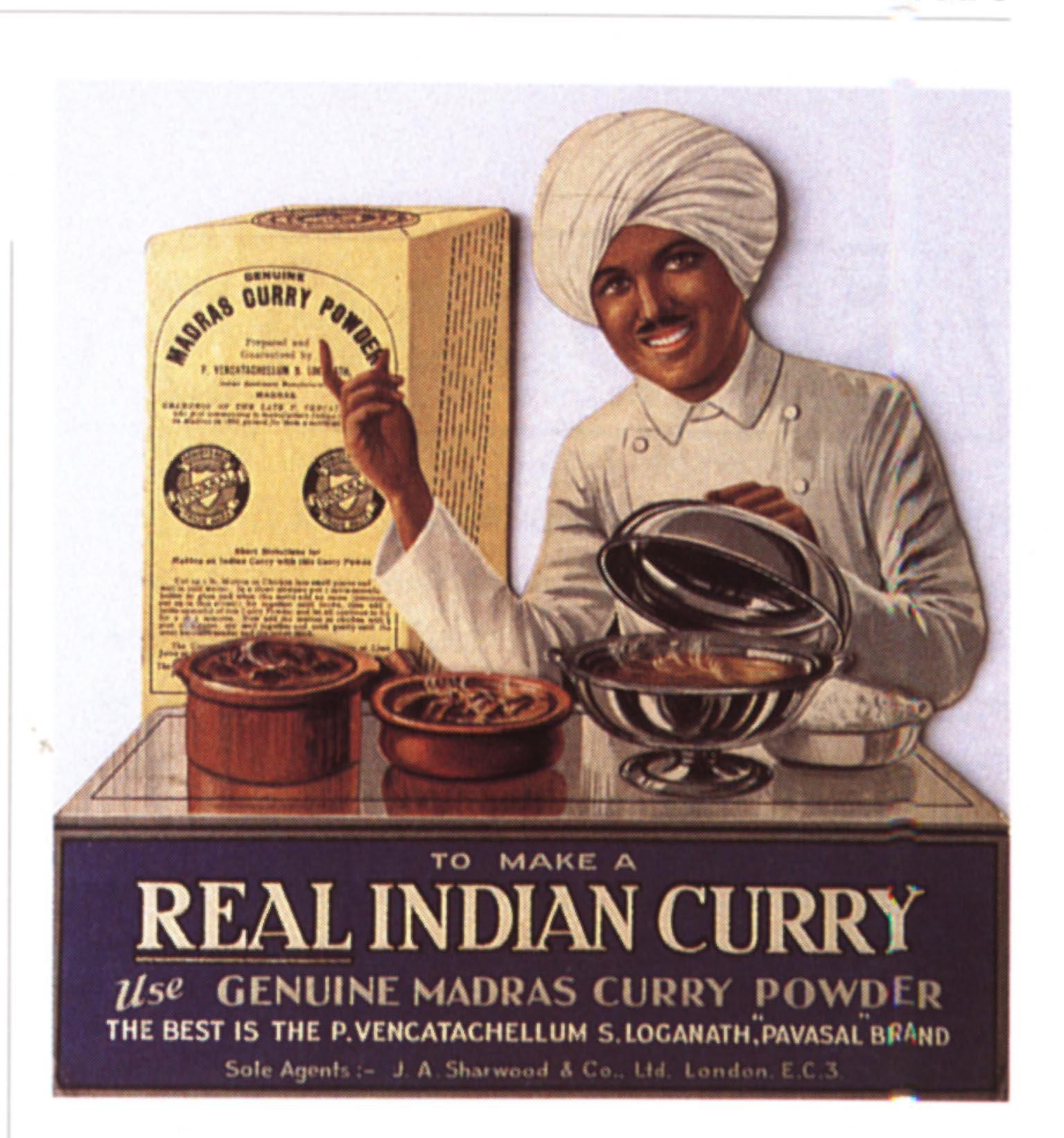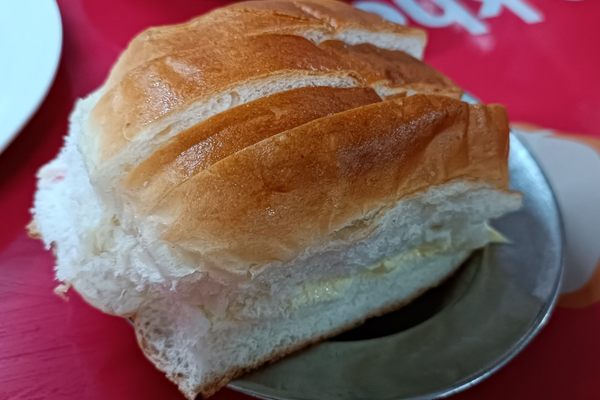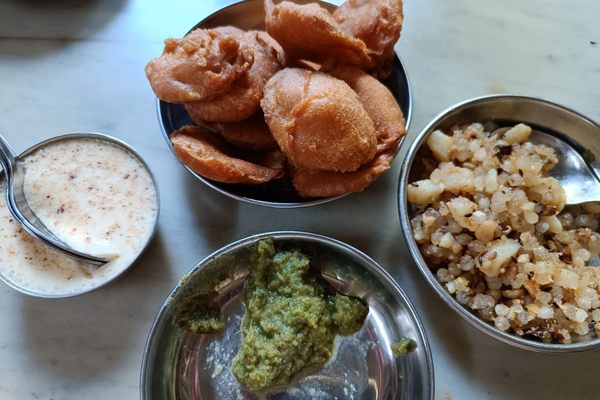The Subversive, Surprising History of Curry Powder
One of India’s most popular gastronomic exports tells a tale of empire.

In the 2001 romantic comedy Bridget Jones’s Diary, the iconic meeting of the film’s lead couple begins with a voiceover as Bridget trudges through the snow down her mother’s driveway: “It all began on New Year’s day, in my 32nd year of being single. Once again I found myself on my own and going to my mother’s annual turkey curry buffet. Every year she tries to fix me up with some bushy-haired, middle-aged bore, and I feared this year would be no exception.” The presence of turkey curry—a hybrid Indian and British food—as the background to this budding British romance reveals how much curry has become synonymous with British culture.
This love of curry, a dish adopted and adapted after the colonization of India, is a relic of when the sun never set on the British Empire. But the term “curry” reflected a willful ignorance of the diversity of Indian food. Lizzie Collingham, who mentions the Bridget Jones scene in her book Curry: A Tale of Cooks and Conquerors, writes that curry was something “the Europeans imposed on India’s food culture.” While their Indian cooks served them rogan josh, dopiaza, and qorma, the British “lumped all these together under the heading of curry.”
Domesticating curry also aided in Britain’s colonizing mission. Susan Zlotnick, a professor of English at Vassar College, has written about how the memsahibs of the British Raj were doing the work of empire by incorporating Indian elements into British cooking and making curry, in essence, culturally British. Cookbooks of the time were “self-conscious cultural documents in which we can locate a metaphor for nineteenth-century British imperialism,” writes Zlotnick. “By virtue of their own domesticity, Victorian women could neutralize the threat of the Other by naturalizing the products of foreign lands.” Taking the culinary wisdom of the colonized, and making it their own, was part of the grand imperial project.
Currying things, with fresh or tinned curry powder, became synonymous with British cookery. Isabella Beeton’s Book of Household Management (first published in 1861) and Eliza Acton’s Modern Cookery in all its Branches (1845), both bestsellers of their time, with several reprints, contained an abundance of curry recipes that called for curry powder. Some, such as Mrs. Beeton’s “fricasseed kangaroo tails,” revealed the multiple threads of colony in a single dish.
This became an enduring legacy of the British Empire and colonization—it sent native foods between colonies and around the world. Much of Indian cuisine today comprises ingredients from the Americas introduced by colonists, such as chilies, potatoes, and tomatoes. Likewise, the spice trade was formative to European colonial conquest, fostering global connections between continents. This was at a time when “Europe was clearly not in the center, but on the margins of a world system centered around Asia and the Middle East,” writes anthropologist Akhil Gupta in the book, Curried Cultures: Globalization, Food, and South Asia. And so, curry powder’s popularity in England ensured its journey to America with early settlers.

According to culinary historian Colleen Taylor Sen, author of Curry: A Global History, Indians arrived in North America almost immediately after the founding of the Jamestown colony in 1607. “The British from the East India Company made great fortunes and came to America, where they had these big estates,” she says. They brought servants and indentured laborers from India for their estates. “India and America were like sister colonies.” Curry made the trip too.
Through the 1800s, curry was a common dish, and curry powder a familiar flavor, in the United States. One of the earliest quintessentially American cookbooks, The Virginia Housewife by Mary Randolph, has at least six recipes that call for curry powder, including one to make the powder. Eliza Leslie’s bestselling Directions for Cookery, in Its Various Branches (1837) contains a “genuine East India receipt for [chicken] curry,” including recipes for mulligatawny soup with freshly ground curry powder. Mrs. Hill’s New Cook-Book (1870), which proclaimed itself “especially adapted to the Southern States,” contained recipes for curried meat stews and roasts, a “rice chicken pie” in a curry powder gravy, several ways to curry a calf’s head, and Mrs. Hill’s own curry powder recipe, made of pounded coriander seed, turmeric, ginger, black pepper, mustard, allspice, cumin, and cardamom.
The expense of shipping spices to the colonies, and to Britain, was probably the primary reason why blended, pre-made curry powder became common. Although there has never been a set combination of spices that goes into curry powder, the British commercialized and sold spice blends under that broad rubric since at least 1784. Not everyone could afford to buy the individual spices and make their own blends. And while Brits in colonial India had servants to freshly grind spices and select the right combinations for each dish, the average home cook in London or Virginia often leaned on one commercial curry powder (and swapped in more familiar techniques and ingredients, such as butter in place of ghee) for all their curries.
As soon as Indians had a voice in the British and American food worlds, they would denounce the use of curry powder, which reduced the region’s rich and varied cuisine to a few mass-produced mixes.
In the United States, this denunciation came strongly after the Immigration and Naturalization Act of 1965, which abolished quotas based on national origins and encouraged high-skilled immigration. The influx of newly-arrived South Asians led to an increase in restaurants catering to these migrants. The face and flavor of curry changed from recipes written by white Americans to ones by South Asian chefs who voiced concerns about authenticity and appropriation while introducing their own versions of Indian food.
“What you don’t need is curry powder,” Madhur Jaffrey, the high priestess of Indian cooking in America, wrote in 1974 in An Invitation to Indian Cookery. “To me the word ‘curry’ is as degrading to India’s great cuisine as the term ‘chop suey’ was to China’s.” She added that “no Indian ever uses curry powder,” nor would they mix their own, since then every dish would taste the same. “If ‘curry’ is an oversimplified name for an ancient cuisine,” she charged, “then ‘curry powder’ attempts to oversimplify (and destroy) the cuisine itself.”

The rage felt toward curry powder was also fueled by the association between curry and racial slurs. While Britain had embraced curry—and Americans followed suit—anti-immigrant sentiments transcended a shared love of food. When Indians migrated to England and sister colonies, the racial epithet “curry-muncher” was the xenophobic response. After the East India Company’s trade monopoly in India ended in 1813, and the British government set up a more solid presence in India, the colonizing mission necessitated a separation from “natives.” Within India, an archetypal colonist discourse around disgust, backwardness, and mistrust set in, along with a need to establish the Englishness of the rulers.
Still, the term curry and Westerners’ taste for it was too strong to ignore. Jaffrey’s early readers were primarily Euro-American, and she went on to write bestselling cookbooks with such names as Madhur Jaffrey’s Ultimate Curry Bible, 100 Essential Curries, and Madhur Jaffrey’s Curry Nation.
Later Indian-origin chefs in the U.S. and England, such as Meera Sodha, Raghavan Iyer, and Julie Sahni, had the benefit of writing and cooking for a more diverse audience that included diasporic Indians. Over time, they reclaimed the word curry by offering traditional or family recipes and introducing a more nuanced view into the diversity and range of Indian cuisine.
None of these authors would be caught dead using store-bought curry powder, but South Asian home cooks began to exert ownership over these products. By the 21st century, South Asian Americans were the fastest growing immigrant group in the United States. Both in the homeland and in the diaspora, double income South Asian households with little time to freshly grind spices and prepare jhalfrezi, qorma, kalia, bhuna, or dopiaza (different forms of dry and gravy-laden Indian dishes that typify curry) reached for commercial spice mixes—the equivalent of the curry powder of yore. Countless food forums include discussions on how best to use these premade blends, which, notably, are never called curry powder, the Hindi term masala (etymologically rooted in Urdu and Arabic) being preferred. Today the Indian premade packaged spice blend is an industry that, by some accounts, is worth a billion dollars. “Biryani masala,” “pav bhaji masala,” “goat curry masala,” and an assortment of masalas to marinate kebabs have become staples of the South Asian pantry. Curry endures, but now in the kitchens of South Asians, and at South Asian restaurants whose fare became considered “ethnic food.”
The decline in the popularity of curry in America—relative to the days when it featured prominently in American cookbooks—can be accorded in part to its reclamation by diasporic South Asians. “Our tastes are probably more racialized than we are willing to acknowledge,” said Krishnendu Ray, Chair of the Department of Food and Nutrition Studies at New York University, in an interview with WNYC. Most of the cuisines that have achieved “elite” status in the U.S. belong to ethnicities now considered white, such as Italian, French, and New American food. “Poor immigrants coming into the country—their food can become popular, but it is very difficult for their cuisine to acquire prestige.” And so, much of Indian, Chinese, and Mexican cuisine today gets relegated to a niche.
Food is often tied to national identity, but the contribution of curry powder to the global kitchen is a noteworthy instance of the early forces of globalization. An invention of a colonial empire, it epitomized Britishness—under the guise of being authentically Indian—and graced the tables of white southerners in America, ultimately drawing the ire of South Asians until it was reclaimed, reinvented, and rebranded under its current avatar as “masala.” The history of this humble kitchen ingredient is the history of empire and its aftermath.
Gastro Obscura covers the world’s most wondrous food and drink.
Sign up for our regular newsletter.

























Follow us on Twitter to get the latest on the world's hidden wonders.
Like us on Facebook to get the latest on the world's hidden wonders.
Follow us on Twitter Like us on Facebook